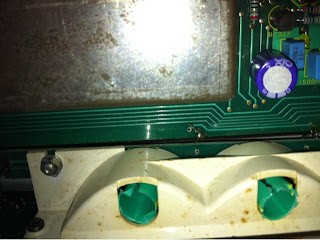Bought the following DIY TDA1541A DAC for a test drive as always been curious of the reproduction quality from such products.
|
|
DIY chasis with everything inside
|
 |
| Size comparison against a CD |
 |
| Rear view |
Initial impressions of the purchase?
The unit was sent via a double-box cocoon. Superb built quality with a solid feel.
 |
Layout within chasis
|
Works fine once the necessary connectors were in-place. Source was the el-cheapo Samsung DVD ($39.90 from a local supermarket chain) via SP/DIF. Initially connected to my Accuphase and later to the Audiolab 8000A to see if there were any difference in the quality of reproduction with different amps in play (no difference). Meridian A500 speakers were deployed.
 |
Close-up of the stars
|
The DIY runs a little warm as the chasis is an enclosed box. Only the red LED is in-used eg indicate power availability, although another two LED(s) were available on the faceplate. Looking about the motherboard, many Chinese brand EC(s) were deployed. Very few EC(s) were ELNA Stargate and Panasonic FC.
Initial impressions from the DAC (straight out of box) reproduction was an off-pitch with a bias towards the HF. After a couple of days, the DAC began to sound right. A week later, I can't help but to BE IMPRESSED!!!
Reproduction was good enough to give my Marantz CDA94 a run for the $$$. Of course the CDA94 wins hands down since it has dedicated power supplies, dedicated clocking board, etc. But for the total cost ... you can't help but to be most impressed by the reproduction capability of the DIY!
1JAN2015
Finally managed to obtained the Philips version of the opamp(s) to replace the TI 5534.
WHAT A DIFFERENCE!!! Vocals are now beautifully reproduced with realistic depth and detail!!
8MAR2015
I added a Wima 0.022uF bypass to each of the output capacitors which are located just before the output RCA jacks.
This was done to lift the super thin veil from the DIY TDA1541 reproduction. The effect of the bypass can be heard after about 30min of usage, resulting in a bigger HF headroom.
Next change would be to replace the Chinese made caps with my preferred ...
27Mar2015
Finally replaced the Chinese made 2x330uF 16V at the output stage and the 10uF 50V from the input with Panasonic FC equivalents. Must say the Panasonic FC replacement(s) made quite an impression as the Chinese made caps tend to be produce flabby bass.
 |
| Chinese-made caps replaced |
 |
| Philips BC 0.027uF bypass on the Panasonic FC 330uF 25V output caps |
 |
| Panasonic FC caps added to the final output stage (next to RCA) |
I used long leads on the bypass(s) as the board is mounted on shorter screws towards the back where the RCA(s) are. Otherwise would not be able to place the board onto the chassis.







































